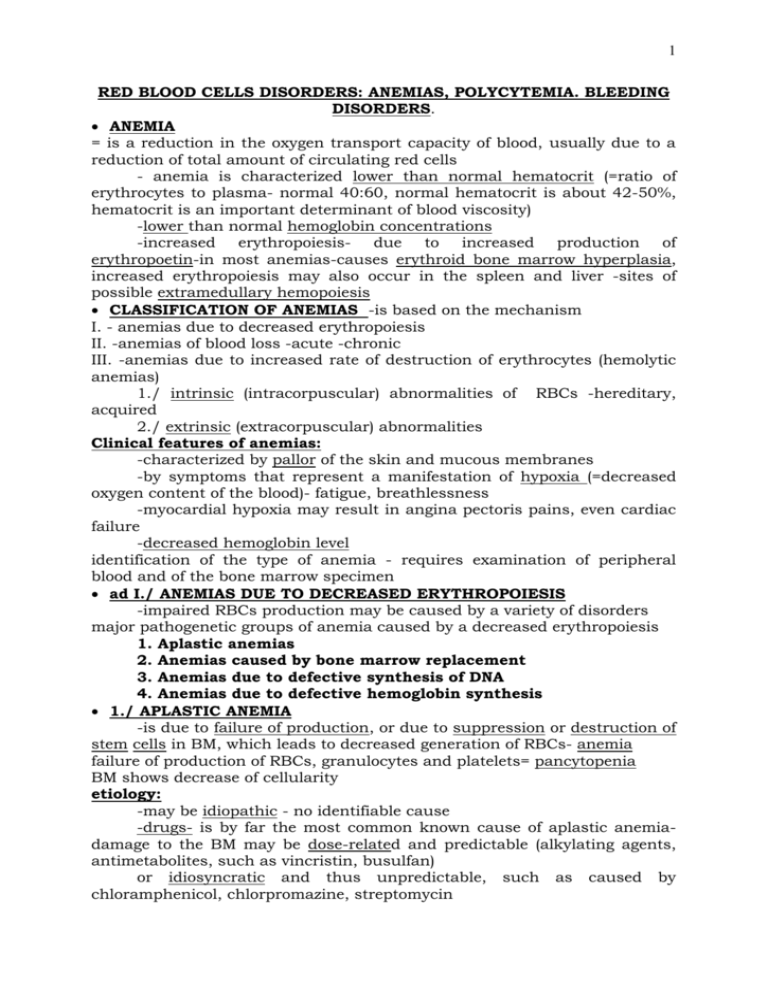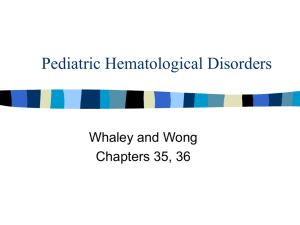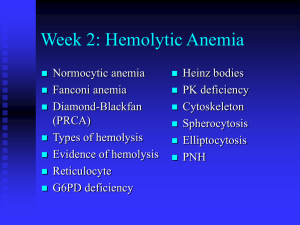I. - anemias due to decreased erythropoiesis
advertisement

1 RED BLOOD CELLS DISORDERS: ANEMIAS, POLYCYTEMIA. BLEEDING DISORDERS. ANEMIA = is a reduction in the oxygen transport capacity of blood, usually due to a reduction of total amount of circulating red cells - anemia is characterized lower than normal hematocrit (=ratio of erythrocytes to plasma- normal 40:60, normal hematocrit is about 42-50%, hematocrit is an important determinant of blood viscosity) -lower than normal hemoglobin concentrations -increased erythropoiesis- due to increased production of erythropoetin-in most anemias-causes erythroid bone marrow hyperplasia, increased erythropoiesis may also occur in the spleen and liver -sites of possible extramedullary hemopoiesis CLASSIFICATION OF ANEMIAS -is based on the mechanism I. - anemias due to decreased erythropoiesis II. -anemias of blood loss -acute -chronic III. -anemias due to increased rate of destruction of erythrocytes (hemolytic anemias) 1./ intrinsic (intracorpuscular) abnormalities of RBCs -hereditary, acquired 2./ extrinsic (extracorpuscular) abnormalities Clinical features of anemias: -characterized by pallor of the skin and mucous membranes -by symptoms that represent a manifestation of hypoxia (=decreased oxygen content of the blood)- fatigue, breathlessness -myocardial hypoxia may result in angina pectoris pains, even cardiac failure -decreased hemoglobin level identification of the type of anemia - requires examination of peripheral blood and of the bone marrow specimen ad I./ ANEMIAS DUE TO DECREASED ERYTHROPOIESIS -impaired RBCs production may be caused by a variety of disorders major pathogenetic groups of anemia caused by a decreased erythropoiesis 1. Aplastic anemias 2. Anemias caused by bone marrow replacement 3. Anemias due to defective synthesis of DNA 4. Anemias due to defective hemoglobin synthesis 1./ APLASTIC ANEMIA -is due to failure of production, or due to suppression or destruction of stem cells in BM, which leads to decreased generation of RBCs- anemia failure of production of RBCs, granulocytes and platelets= pancytopenia BM shows decrease of cellularity etiology: -may be idiopathic - no identifiable cause -drugs- is by far the most common known cause of aplastic anemiadamage to the BM may be dose-related and predictable (alkylating agents, antimetabolites, such as vincristin, busulfan) or idiosyncratic and thus unpredictable, such as caused by chloramphenicol, chlorpromazine, streptomycin 2 -irraditaion -some infections or inherited diseases, like Fanconi anemia, which is associated with multiple congenital anomalies pathogenesis: -in idiopathic cases, the stem cell failure may be due to primary structural defect of stem cells (BMT) -or mediated by immune-suppression of the stem cells, then may be reversed by immunosuppression therapy morphology: -bone marrow is hypocellular - active BM is replaced by fat cells clinically: -all symptoms are related to pancytopenia -leading feature is usually bleeding diathesis 2./ ANEMIAS DUE TO BM REPLACEMENT a) involvement of the bone marrow cavity by malignant tumors -most often-in leukemias- malignant neoplastic proliferations of hematopoietic cells - infiltration of BM by malignant lymphoma- neoplastic proliferation derived of lymhpoid cells arising most often in lymph nodes - infiltration by metastatic carcinomas, such as breast ca, bronchogenic ca, etc b) replacement of the BM by fibrosis - in osteomyelofibrosis compensatory phenomen include -extramedullary hematopoiesis - development of active marrow in sites outside the bone marrow cavity- (spleen,liver) -release of cells from the marrow before maturation is complete -results in „shift to left“- implies a release of immature white cells including the band forms and even of myeloblasts and myelocytes and normoblasts ( nucleated RBCs ) into the peripheral blood 3./ ANEMIAS DUE TO DEFECTIVE SYNTHESIS OF DNA= MEGALOBLASTIC ANEMIAS megaloblastic anemias - are characterized by disorder in maturation phase of erythropoiesis resulting in formation of abnormal erythroid precursors which are enlarged and show failure of maturation - these are called megaloblasts etiology: -megaloblastic anemias result from conditions in which DNA synthesis in erythropoiesis is abnormal, for example due to -vitamin B 12 deficiency -folic acid deficiency Both play role as cofactors in the synthesis of DNA (intrinsic factor= produced by mucosa cells in the stomach- enables B12 vitamin to be absorbed properly from the food) -vitamin B12 is present in high concentrations in the liver and meat of animals, but is absent of plants- dietary B12 vitamin deficiency is rare, except of strict vegeterians 3 -folic acid is present in most vegetables- dietary deficiency is more commonin many states of malnutrition there are two principal forms of megaloblastic anemias a) anemia due to B12 deficiency b) anemia due to folic acid deficiency a) Anemia due to B12 deficiency - has several possible causes, including so-called A) PERNICIOUS ANEMIA -is a form of megaloblastic anemia due to B12 deficiency -it is common in western Europe and in the U.S. but is rather rare in Asia and Africa -PA - occurs predominantly after the age of 50 -slightly more often in males pathogenesis -is an autoimmune disease caused by immunologic destruction of the gastric mucosa microscopically: - the mucosa of the body and the fundus of the stomach is characterized by diffuse lymphocytic infiltration and progressive loss of parietal cells chronic atrophic gastritis -associated with a failure of secretion of acid (achlorhydria) and intrinsic factor- leads to drastic reduction of B12 vitamin absorbtion pathologic and clinical features in PA: -chronic atrophic gastritis-achlorhydria-failure of intrinsic factor secretion-leads to B12 vitamin deficiency -megaloblastic anemia -neurologic abnormalities due to demyelination (pathogenesis not clear) very characteristic-subacute combined degeneration of the spinal cord ( demyelination of the posterior and lateral collumns of the cord ) -leads to loss of position and vibration sense to loss of tendons reflexes -peripheral neuropathy due to demyelination of nerves treatment -replacement therapy by injected B12 vitamins- anemia improves rapidly and completely, neurologic symptoms slowly and incompletely -precancerous epithelial dysplasia in chronic atrophic gastritis- can be detected by gastric mucosa biopsy other causes of B12 vitamin deficiency different from PA include: -inadequate dietary habits- only in strict vegetarians -total gastrectomy -Crohn disease- chronic idiopathic inflammatory large bowel disease -surgical removal of terminal ileum, -by-pass of terminal ileum - B12 vitamin complexed to intrinsic factor is normally absorbed in terminal ileum -severe bacterial infection of large intestine B) ANEMIAS DUE TO FOLIC ACID DEFICIENCY -has several underlying causes including -inadequate intake in food- in chronic alcoholism, in severe malnutritions -due to failure of absorbtion- in malabsorbtive syndromes, such as tropical sprue, coelic disease 4 -in states of increased demand, such as in pregnancy, in malignant tumors- due to increased synthesis of DNA in malignant cells -anticancer drugs- such as methotrexate - have antagonistic effect to folic acidPathologic findings in all megaloblastic anemias: -RBCs changes- most apparent- erythropoiesis changes from normoblastic to megaloblastic megaloblast - larger than normoblast, shows delayed maturation but normal cytoplasmic hemoglobinization, primitive nucleus and fully hemoglobinized cytoplasm -changes in BM- accumulation of erythrocyte precursor cells - BM is hypercellular- resembles acute blastic leukemia -changes in peripheral blood- shows macrocytosis- large RBCs with anisocytosis-marked variation in size poikilocytosis-marked variation in shape -changes in neutrophils- neutrophil precursors in the BM show enlargment- giant metamyelocytes are characteristic in peripheral bloodhypersegmented nuclei in lekocytes -changes in other cells- disorder in DNA synthesis affects predominantly those cells with high rate of cell turnover ( intestinal epithelium- enlarged nuclei ) Clinical symptoms in megaloblastic anemias -severe anemia -macrocytosis and hypersegmented leukocytes in peripheral blood -bone marrow examination reveals hypercellularity- megaloblastic erythroid hyperplasia 4./ ANEMIAS DUE TO DEFECTIVE HEMOGLOBIN SYNTHESIS includes three major clinicopathologic entities a) iron deficiency anemia b) anemia in chronic diseases c) sideroblastic anemia A) IRON DEFICIENCY ANEMIA -is by far most common type of anemia worldwide Causes of iron deficiencies -iron deficiencies due to dietary deficiency- most common in underdeveloped countries -increased demand of iron- in growth phase in early infancy or in adolescence in pregnancy and lactation -malabsorbtion of iron- in severe generalized states (coelic disease, tropical sprue, etc) -after total gastrectomy- gastric acid is necessary for complete absorbtion of iron -chronic blood loss- major cause of iron deficiency anemia results either from -occult GIT blood loss due to hookworm infection- small parasitic intestinal worm (ancylostomiasis)= disease characterized by anemia, GIT pains, weakness -(larvae enter the body through the skin) -occult GIT bleeding due to chronic ulcers, cancers, hemorrhoids, esophageal varices 5 Pathologic findings: -in iron deficiency- the first symptom- decreased serum level of ferritinreflects the level of storage of iron -absence of iron in BM specimens when iron stores are exhausted- the serum iron level falls -anemia is due to both a decresed amount of hemoglobin in individual RBC ( erythrocytes are poorly hemoglobinized) and decrease of total amount of RBCs erythrocytes are small- microcystosis- hypochromic microcytic anemia -bone marrow changes- shows variable normoblastic hyperplasia -storage iron is absent -epithelial changes- result in atrophy of many epithelial surfaces, such as mucous membranes of the mouth, tongue, stomach Plummer-Vinson syndrom= iron deficiency anemia+ atrophic glossitis+ dysphagia +koilonychia (concave fingernails) treatment: -iron replacement therapy and to find and correct the reason for anemia (ulcers, cancers) B) ANEMIAS IN CHRONIC DISEASES -in chronic renal failure- normochromic normocytic anemia due to failure of normal secretion of erythropoetin in the kidney -BM shows mild erythroid hyperplasia C) SIDEROBLASTIC ANEMIA -is uncommon type of anemia characterized by the presence in the BM of increased numbers of sideroblasts= erythroid precursors with iron in their cytoplasm -it has a variety of possible causes both primary and secondaryprimary - may be inherited or acquired (of unknown causes) secondary- in chronic alcoholism, due to drugs, such as chloramphenicol, poisoning- chronic lead poisoning Pathologic findings: -SA is characterized by hypochromic microcytic or dimorphic anemia, it means that in the PB- mixture of normal erythrocytes, microcytes and macrocytic erythrocytes serum iron level increased pathogenesis: defect in incorporation of iron into the hemoglobin molecule II. ANEMIA OF BLOOD LOSS -acute- acute hemorrhage results in a loss of whole blood leading to hypovolemia- equivalent amounts of RBCs, white cells and serum are lostthus, main blood values are normal- at first stage -within hours- water retention (important compensatory mechanism for hypovolemia) - results in decrease of RBCs count, decrease of hemoglobin concentration, decrease of hematocrit in PB -regeneration of erythrocytes- bobe marrow shows erythroid hyperplasia anemia is temporary, body iron storage is replenished over the next few months -chronic- chronic bleeding is compensated by erythroid hyperplasia of BM until Fe stores are exhausted -after this point- iron deficiency anemia develops 6 III.HEMOLYTIC ANEMIA- due to increased rate of destruction of RBCs -group of diseases characterized by shortened survival of RBCs in PB RBCs destruction occurs EXTRAVASCULAR HEMOLYSIS-is characterized by -1.-hemolytic jaundice-increased production of unconjugated bilirubin because of increased breakdown of hemoglobin -unconjugated bilirubin is complexed with plasma albumintransported to the liver- taken up by liver cells-jaundice develops when the amount of unconjugated bilirubin delivered to the liver exceeds the capacity of the liver to conjugate -2.-increased level of bilirubin in bile- the liver excretes increased amounts of conjugated bilirubin into the bile- bilirubin pigment stones formation in the gallbladder -3.-increased amount of urobilinogen- in urine, in large intestine content -4.-erythroid hyperplasia- BM shows hyperplasia- expansion of BM cavities- increased erythropoiesis results in release of reticulocytes into PB -5.-hemosiderosis-degradation of hemoglobin from the destroyed RBCs- deposition of hemosiderin ( spleen, liver) INTRAVASCULAR HEMOLYSIS is characterized by -1.-hemolytic jaundice- unconjugated bilirubinemia -2.-erythroid hyperplasia- in chronic hemolysis only -3.-hemoglobinemie free hemoglobin in plasma appear when hemolysis has exhausted the capacity of plasma haptoglobin to bind hemoblobin -4.-hemoglobinurie -hemoglobin molecule may pass the glomuruli CLASSIFICATION OF HEMOLYTIC ANEMIAS 1) intrinsic defects of erythrocytes (intracorpuscular anemia) a- hereditary1- RBC membrane disorders or cytoskeleton disorders -spherocytosis -eliptocytosis 2- RBC enzyme deficiency -G-6-PD (glucose-6-phosphatase-dehydrogenase deficiency) 3- hemoglobinopathies- hemoglobin synthesis disorders - thalassemias -sickle cell anemia b-acquired hematologic diseases - PNH 2) hemolysis due to extrinsic factors (extracorpuscular anemias) immune anemia other causes ad 1) intrinsic defects of erythrocytes ad 1a) hereditary: HEREDITARY SPHEROCYTOSIS -is congenital autosomal dominant disease with variable penetrance 7 -patients may present with severe hemolysis in childhood or mild hemolysis in adult age -is characterized by change in shape of RBCs from the normal biconcave shape to a spherical shapepathogenesis: proteins of red cell membrane are defective in structure or reduced in amount- results in reduction of cell surface- causes that RBCs assume a spheroidal shape -spherical RBCs are more fragile- increased fragility - spherocytes are more susceptible to lysis- s. show autohemolysis- when incubated at 37 C for 2448h -life span of spherocytes is shortened- destruction occurs in the spleen clinical features: -patients present with anemia and jaundice -splenic enlargement- histologically splenic cords of Billroth are markedly congested and exhibit prominent erythrophagocytosis -peripheral blood- shows spherical microcytes -bone marrow shows normoblastic hyperplasia -aplastic crisis may occur rapidly-associated with acute infection treatment: splenectomy- removal of the site of maximum erythrocyte destruction ad 2 ) GLUCOSE-6-PHOSPHATASE-DEHYDROGENASE DEFICIENCY (G6PD) -most common erythrocyte enzyme deficiency- RBCs are more vulnerable to oxidants -it is a X-linkedinherited anomaly-full expression of deficiency occurs in males hemolytic attacks trend to affect older RBCs clinically: -most patients are asymptomatic, but acute intravascular hemolysis may occur due to exposure of oxidant drugs, such as sulfonamide, nitrofurantoin, etc. -rarely patients develop mild chronic hemolytic anemia ad 3 ) hemoglobinopathies 1.- THALASSEMIAS -is a heterogenous group of congenital disorders, characterized by a lack or decreased rate of synthesisof either normal alfa- or the beta chains of hemoglobin A thalasemias are more common in Mediterranean, in Africa and Southeast Asia beta-thalassemia- decrease of synthesis of beta-globin- free alfa chains form highly unstable aggregates - cell membrane damage- destruction of RBC precursors alfa-thalassemia- inbalance in sxynthesis of alfa chain morphology: -in peripheral blood- microcytic anemia with marked anisocytosis -in bone marrow- ineffective erythropoeisis - due to destruction of RBC precursors in BM- erythroid hyperplasia -in spleen- hemolysis of abnormal RBCs- activation- splenomegaly -positive iron balance due to increased absorbtion of iron in the intestine and due to transfusions- lead to severe iron overload- secondary hemochromatosis- myocardial or liver failure 8 2.- SICKLE CELL DISEASE -is a hereditary hemoglobinopathy caused by a single point mutation of the globin gene- that causes a replacement of aminoacids, of normal Hb glutamic acid for valine in beta chain -results in formation of hemoglobin-S morphology: -occurrence of so-called sickle cells- erythrocytes of pathologic shape, that under decreased oxygen lead to formation of so-called tactoids -deformation of RBCs and decreased solubility of hemoglobin initially sickling can be reversed to normal shape-when oxygenation improves later, however, the shape of RBCs becomes permanent increased phagocytosis and destruction of the RBCs in the spleen clinically: onset in early childhood- death in young adult age -patients present with chronic extravascular hemolysis and severe anemia- chronic hemolytic state-sicle cells have rigid membranes- prone to sequestration -growth retardation -mild hemolytic jaundice -there is also tendency to microvascular occlusions- because sicle cells have a propensity to adhere to capillary endothelium BM shows marked hyperplasia- compensatory normoblastic complications: aplastic crisis- may cause sudden failure of hematopoiesis- may be due to acute infection, drugs, other causes hemosiderosis-due to multiple blood transfusions and because of stimulation of absorbtion of iron in the intestine vaso-occlusive crisis- is due to filling the microcirculation by aggregates of sickle cells- cause multiple small infarctions-painful episodes of ischemic necroses fever, ischemic pains-heart, skeletal muscels, bones-aseptic bone necrosis splenic changes-are characteristic- enlargment, and due to repeated infarctions- multiple small scars with heavy hemosiderin deposition- called „ autosplenectomy“thus the patients have higher propensity to infections ad 1b)- acquired: PAROXYSMAL NOCTURNAL HEMOGLOBINURIA ( PNH) -is a rare acquired disease of RBCs characterized by an increased sensitivity of RBC membrane to complement-results in chronic intravascular hemolysis -complement activation may occur in vivo during sleep-because of decreased pH-due to slower respiration- results in paroxysmal nocturnal Hb-uria -patients are young, anemia may be severe pathogenetically related to aplastic anemia-PNH represents a clone of abnormal erythrocytes developing in hypoplastic BM 2) hemolysis due to extrinsic factors (extracorpuscular anemias) 1- anemias mediated by antibodies- both autoimmune and isoimmune 2- mechanical trauma to RBCs 3- infections 9 4-chemical injury of RBCs- like lead poisoning 5- sequestrations of RBCs- for example in hypersplenism ad1.- IMMUNE-MEDIATED HEMOLYTIC ANEMIAS among immune-mediated anemias, there are two major pathogenic groupsautoimmune and isoimmune AUTOIMMUNE HEMOLYTIC ANEMIAS -group of diseases in which hemolysis occurs as a result of the presence of auto-antibodies againts blood group associated antigens -idiopathic warm autoimmune hemolytic anemia -idiopathic cold autoimmune hemolytic anemia -paroxysmal cold hemoglobinuria ISOIMMUNE HEMOLYTIC ANEMIAS -are those in which the RBCs are destroyed as a result of the activity of antibodies of another person, -in blood tranfusion of incompatible blood - hemolytic reaction is rapid -if severe - intravascular hemolysis results in hemoglobinemia such patient develop rapid shock- risk of death -less severe reactions due to non-complement-fixing antibodies - hemolytic disease in newborn -due to Rh incompatibility -drug induced hemolysis- may use several possible mechanisms induction of antibodies- metyldopa or drug complexes with RBC membrane and this complex becomes antigenic- penicilin,cephalosporines ad 2.- mechanical trauma to RBCs MICROANGIOPATHIC HEMOLYTIC ANEMIAS -is caused by fragmentation of RBCs as they pass abnormal microcirculation -in DIC- fibrin strands- fragmentation of RBCs- hemolysis result in -1) hemolytic uremic syndrome -2) thrombotic thrombocytopenic purpura -in abnormal blood vessels- in malignant hypertension -in giant capillary hemangioma and malignant blood vessel tumors -in prosthetic valves- causes trama to RBC, ad 3.- HEMOLYSIS CAUSED BY INFECTION -several possible mechanisms may be involved including -development of autoimmune hemolysis (infective mononucleosis, mycoplasma infections) -production of hemolytic toxins (clostridia, streptoccoci) -direct infection of RBCs -in malaria- red blood cell lysis occurs in attacks when a release of merozoites from infected RBCs occurs (Plasmodium vivax) fever, splenomegaly, BLEEDING DISORDERS - disorders characterized by an increase in tendency for bleeding, may be caused by I.-increased fragility of blood vessels II.-disorders of platelets III.-defects in coagulation 10 I. DISORDERS DUE TO INCREASED VASCULAR FRAGILITY -disorders in this group are relatively common, but usually do not cause serious bleeding -most of them result in multiple petechiae or purpuric hemorrhages -platelet count is normal possible conditions resulting in this type of bleeding diathesis include: -infections- underlying mechanismes are vasculitis or DIC -drug reactions-often mediated by immune complexes in the vessel walls with production of a acute vasculitis Henoch-Schonlein purpura- a systemic hypersensitive reaction of unknown cause, characterized by abdominal pains, polyarthralgia, acute glomerulonephritis- associated with deposition of immune complexes II.-DISORDERS OF PLATELETS A) decrease in number of platelets -THROMBOCYTOPENIA B) defective function of platelets THROMBOCYTOPENIA =decrease in platelet number ( normal count 150-300 thousands per mm3)- decrease to 10 thousands and lower levels causes bleeding tendency -characterized principally by petechial bleeding- most often from small vessels of the skin and mucous membranes possible causes include: -decreased production of platelets- occurs in generalized diseases of the BM, such as in aplastic anemia,disseminated cancer, leukemias -decreased platelet survival-results from immunologically medited destruction of platelets- may follow drug administration, such as methyldopa or infections, for example AIDS -there is compensatory megakaryocytic hyperplasia -sequestration-may occur in the presence of splenomegaly -the syndrom is called hypersplenism -splenectomy can cure most common clinicopathological entities associated with thrombocytopenias are: 1.-IDIOPATHIC THROMBOCYTOPENIC PURPURA (ITP) -is associated with immunologically mediated destruction of platelets two forms are recognozed: acute ITP -is a self-limited disorder- most common in children after viral infections ( viral hepatitis, infectious mononucleosis, rubeolla, cytomegalovirus infections, etc. ) -platelet destruction is probably caused by antigen-antibodies complexes, directed against viruses, absorbed however on platelets chronic ITP -destruction of platelets results directly from the presence of anti-platelets antibodies -in most patients the platelet-associted IgGs can be identified 11 -destruction of antibody-coated platelets occurs in the spleen-splenectomy is beneficial for more than 80% of patients clinical features of ITP: -chronic ITP occurs most often in women, of medium age -it may be associated with other autoimmune disorders, such as autoimmune hemolytic anemia,systemic lupus erythematodes,etc. -most commonly slowly progressive course, with petechial chronic bleeding, such as nose bleed, but sometimes more serious complications like for example melena, hematuria or intracerebral hemorrhages may appear 2.- ISOIMMUNE THROMBOCYTOPENIA -group of disorders that result from development of antibodies directed againts specific platelet antigens -after transfusions -neonatal thrombocytopenia- similar pathogenesis as in fetal erythroblastosis ( platelet-antigen-negative mother carrying antigen-positive baby develop antibodies againts platele-antigen that may cross the placfenta and cause thrombocytopenia in the newborn 3.- THROMBOCYTIC THROMBOCYTOPENIC PURPURA (TTP) -rare disorder characterized by thrombocytopenia, microangiopathic hemolytic anemia and fever, neurologic symptoms and renal failure -most clinical symptoms are due to formation of multiple hyaline microthrombi pathogenesis immunologic reaction is directed against endothelial cells, results in pathologic aggregation of platelets- formation of microthrombi- in contrast to DIC, activation of clotting system is not primary clinically: more commonly in females- peak age about 40years of age treatment with corticosteroids IIB.HEMORRAGIC DISORDERS RELATED TO DEFECTIVE PLATELET FUNCTION -characterized by prolonged bleeding time associated with normal platelet count may be congenital or acquired congenital -there may be defects in platelet adhesion (congenital deficiency of platelet-membrane glycoprotein) or defects in platelet secreting activity-platelet cannot produce prostaglandins, etc. acquired- many possible conditions, of which two are of clinical importance aspirin is known to supress the synthesis of thromboxane which is necessary for platelet aggregation- used in supplementary treatment of IM bleeding in uremic patients may be partly due to defects in platelet function III.HEMORRHAGIC DIATHESIS DUE TO ABNORMALITIES IN CLOTTING FACTORS -bleeding seen in patients with abnormalities in clotting system in contrast to bleeding in platelet deficiencies is characterized by -more often the bleeding is not spontaneous, more likely develops after injury or surgical procedure, but is usually serious, with prolonged bleeding and large hematomas and hemorrhages 12 -most common sites of bleeding is the GIT, urinary tract and particularly large joints and the soft tissues in their vicinity -clotting abnormalities may be due both to hereditary disorders, such as in hemophilia and von Willebrand Disease- it was already mentioned before or may be acquired-most important clinical settings in this respect are the vitamin K deficiency, most often caused by liver failure and DIC- that produces a deficiency of multuple coagulation factors DISSEMINATED INTRAVASCULAR COAGULATION (DIC) -is an acute, subacute or chronic thrombohemorrhagic disorder occurring as a secondary complication of a variety of diseases: -is characterized by activation of the clotting system leading to formation of multiple microthrombi throughout the microcirculation- the consequence of which is consumption of platelets, fibrin and coagulative factors, secondarily leading to activation of fibrinolytic system thus, the DIC presents with -signs and symptoms related to infarctions caused by microthrombi -signs of hemorrhagic diathesis due to depletion of the elements necessary for hemostasis and even due to secondary activation of fibrinolytic processes pathogenesis: there are two major mechanisms by which the DIC may be triggered: 1) release of tissue factors and thromboplastic substances into the circulation -these substances may be derived from various sources, such as placenta in various obstetric complications, bacterial endotoxins, particularly in gram-negative sepsis, etc. 2) widespread injury to the endothelium -endothelial injury can initiate DIC by causing release of thromboplastic factor from endothelial cells, by promoting the platelet aggregation, by activating the intrinsic pathway of clotting cascade -this endothelial injury may be produced by depositions of antigenantibodies complexes morphology: -microthrombi with infarctions in multiple organs and hemorrhages clinically significant changes are encountered in : kidneys- thrombi in glomeruli and renal cortical microinfarcts lungs- microthrombi in alveolar capillaries- may cause clinnically acute respiratory distress syndrome brain- microinfarcts and fresh hemorrhages placenta-widespread thrombi clinical features: about 50% of patients with DIC are abstetric patients with complications of pregnancy - sepsis and major trauma- rest of patients other causes- rare major clinical manifestations of DIC: 13 -microangiopathic hemolytic anemia resulting from microvascular occlusions -respiratory symptoms including cyanosis, dyspnea -neurologic symptoms including convulsions -oliguria and renal failure -circulatory failure and shock the prognosis and treatment is highly variable and depends on the underlying disorder- administration of either aggressive anticoagulants, such as heparin and antithrombin -or coagulants usually in the form of fresh-frozen plasma







